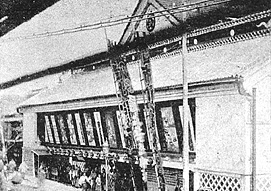Column <Tokyo>
9 Theatrical Performances and Theaters in the Meiji Era (1):
Shintomiza--Morita Kanya's Western Influence
Following the Tempo Reforms (1841-43) of the Edo period (1603-1867), three theaters located in Edo and licensed by the government, namely Ichimuraza, Nakamuraza, and Moritaza, were relocated to the Asakusa district. Among them, Moritaza was shifted to Shintomicho, Kyobashi-ku (Kyobashi Ward) (present-day Shintomi, Chuo-ku) in 1872, and its name was changed to Shintomiza in 1875. The following year, however, the theater was gutted by fire. Its replacement, built in 1878, was fitted with chairs and gas lamps, and was considered quite Westernized. Many foreign nationals living in Tokyo attended the opening ceremony on June 7, 1878.
Thomas McClatchie, who was at that time posted at the British Legation in Tokyo, was one of the foreign invitees. He noted that in his country many people had expressed worry about the attitude in Japan toward foreign nationals, pointing to comments like, "In Japan, ronin with long swords will immediately cut foreign nationals down when they encounter them." This, however, was untrue. On the contrary, McClatchie was invited to a beautiful theater and enjoyed watching the opening night performances, later taking the time to write home to his mother and friends about the experience. Furthermore, with the help of Okamoto Kiyoshi (Keinosuke) who was a friend of Ichikawa Danjuro IX and the father of playwright Okamoto Kido, and was working for the British Legation at that time, McClatchie took the initiative among the foreign invitees to later present a gift to Shintomiza. On February 3, 1879, Tokyo's official foreign contingent presented a beautiful drawing curtain to the theater. Printed on the curtain, which was made from purple satin and encompassed intricate pine, bamboo and plum designs, were "katabami, " an emblem constantly used by the theater's general manager Morita Kanya, along with the phrases "To Mr. Morita" and "From the Foreign Nationals in Tokyo." Morita was elated, saying "It (the gift) is a great honor and pleasure to me and to future generations." Morita immediately hang the curtain for the March performance that started on February 28.
Just a few months later on July 16, 1879, Ulysses Simpson Grant, a former United States' president, visited Shintomiza. To honor his visit, the national flags of both the United States and Japan, each made using six rolls of cloth, were posted at the entrance of the theater, while smaller flags were hung along the main street leading to the theater as well as on the stage. At the end of the play, more than 70 geisha took to the stage draped in red and white horizontal-striped kimono and blue juban (underwear) with white stars to represent the Stars and Stripes in what was a breathtaking performance of dance.
Going by records of the day, it appears Morita was in fact very westernized. In March 1879, Okamoto Kido met Morita, who had come to see his father. Kido later recalled, "Mr. Morita gave a gift to my father, which was Western confectionary he had bought at Fugetsudo. Only very westernized people carried Western confectionary with them around 1879."
This outlook, however, soon came to plague Morita. For the September performance of 1879 (Genpei Nunobiki no Taki Hyoryu Kidan Seiyo Geki), Morita hired eight British actors. The audience, however, did not understand what the foreign actors were saying and the play was much criticized, with comments like, "What the Westerners were saying did not make sense at all, " "The voice of a British actress sounded just like the barking of a Western dog, " and "Most of the audience did not understand the play at all, and they just kept laughing and laughing." Not long after, Morita fell into huge debt.
It was said that the failure of the performance led Morita to tone down his enthusiasm for all things Western. Nevertheless, Shintomiza continued to prosper as Japan's No. 1 first-class theater with first-class actors and later rivaled Kabukiza, which was opened in 1889.
Kaburaki Kiyotaka described the theater area as follows: "Theaters were lined along the street from the corner of the Tsukiji Bridge to the crossroads in the direction of the Sakura Bridge. Facing these theaters across the street, there were teahouses. ... Centering around these theaters, the area as a whole provided a gorgeous atmosphere of a different world."
Reference
- The Daily YomiuriÅyYB-41Åz
- Ihara Toshio, Kabukinenpyo, Iwanami Shoten, 1962 Åy774.032-I157k-KÅz
- Ueda Bin, "Kokuristugekijo no Hanashi" Bungei Kowa, Kanao Bunendo, 1907 Åy74-360Åz
- Okamoto Kido, Lamp no Shitanite (Iwanami Bunko), Iwanami Shoten, 1993 ÅyKD487-E43Åz
- Okamoto Kido, Yamada Hajime (ed.), Fuzoku Meiji Tokyo Monogatari (Kawade Bunko), Kawade Shobo Shinsha, 1987 ÅyKH465-E2Åz
- Kaburaki Kiyotaka, Yamada Hajime (ed.), Meiji no Tokyo (Iwanami Bunko), Iwanami Shoten, 1989 ÅyKC19-E9Åz
- Shinoda Kozo, Meiji Hyakuwa, Vol. 2 (Iwanami Bunko), Iwanami Shoten, 1996 ÅyGB415-G7Åz
- Suematsu Kencho, Engeki Kairyo Iken, Bungakusha, 1886 Åy25-286Åz
- Mine Takashi, Teikoku Gekijo Kaimaku (Chuko Shinsho), Chuokoronsha, 1996 ÅyKD11-G10Åz
- Yamamoto Shogetsu, Meiji Seso Hyakuwa(Chuko Bunko), Revised ed. Chuokoronshinsha, 2005 ÅyGB415-H47Åz
- Kabukiza Hyakunenshi Honbunhen, Vol.1, Shochiku, 1993 ÅyKD11-E21Åz
- Engeki Hyakka Daijiten, Heibonsha, 1960-62 Åy770.33-E742-WÅz
- Kokushi Daijiten, Yoshikawa Kobunkan, 1979-97 ÅyGB8-60Åz
